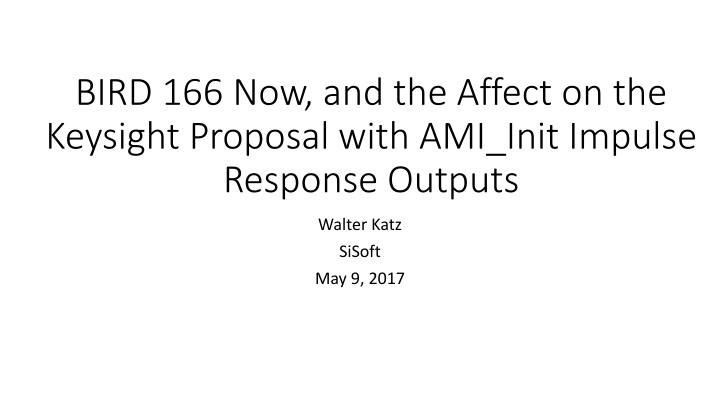
Keysight Proposal with AMI_Init Impulse Response Outputs
Explore the impact of BIRD.166 on the Keysight proposal, highlighting the AMI_Init impulse response outputs. Delve into the complexities of repeater links, dual models for Tx1 and Rx1, and the challenges faced in determining the combined impulse response correctly. Understand the flow in IBIS 6.1 and the considerations for simulating downstream channels in the presence of redrivers.
Download Presentation

Please find below an Image/Link to download the presentation.
The content on the website is provided AS IS for your information and personal use only. It may not be sold, licensed, or shared on other websites without obtaining consent from the author. If you encounter any issues during the download, it is possible that the publisher has removed the file from their server.
You are allowed to download the files provided on this website for personal or commercial use, subject to the condition that they are used lawfully. All files are the property of their respective owners.
The content on the website is provided AS IS for your information and personal use only. It may not be sold, licensed, or shared on other websites without obtaining consent from the author.
E N D
Presentation Transcript
BIRD 166 Now, and the Affect on the Keysight Proposal with AMI_Init Impulse Response Outputs Walter Katz SiSoft May 9, 2017
Repeater Link Repeater Rx2 channel 2 Tx1 channel 1 Rx1 Tx2 outgoing Incoming Repeater Repeater Tx (downstream) (upstream) Rx channel channel
Tx1 and Rx1 are Dual Models, Tx2 and Rx2 are both Init-only Slide 3 Problem_in_BIRD166_Flow.pptx ??? ?????? ?? = ?? ????(?) ?(?) ??????(?) Tx1 Channel 1 Rx1 Rx2 Tx2 Channel 2 ? ??+? ??= ?? ? ??+?= ??????? ?? ? (?? ???????+ ???????) ????? = ??????(?) ?? Now rewrite Rx1 GetWave output as VRx1GW(t) = d(t) h1 + V. Here V represents Nonlinearity in Rx1, e.g. limiting mode redriver and compression Redriver internal noise Xtlk signals that enter Rx1 ? ??????? ????? = + ?? ?? 1= 1/???{ 1}. If upstream channel has X dB loss, then Note that ??? 1 redriver nonlinearity, noise and xtlk are amplified by X dB when they reach Rx2 DFE 4/4/2025 3
In Slide 4 Problem_in_BIRD166_Flow.pptx, Fangyi Contemplates The time domain waveform at the output of Rx2 is determined by convolving the output of Rx1 AMI_GetWave with some IR that represents the IR of Tx2, Channel 2, and Rx2, and that there is no valid way of determining this combined IR correctly and also include as input to the Rx2 the IR of the full channel including the section between and including Tx1 and Rx1. The current flow in IBIS 6.1 does not say to do this.
The current flow in IBIS 6.1 does says: In the Repeater Flow Section Step 8a. Redriver: The simulation platform uses the signal waveform at the output end of Rx1 s algorithmic model in step 7, regardless whether Rx1 s AMI_GetWave exists or not, as the stimulus of Tx2 s algorithmic model, regardless whether Tx2 s AMI_GetWave exists or not, and performs simulation on the downstream channel, which consists of Tx2, physical channel 2 and Rx2, according to the AMI flow defined in the spec for channels without Redrivers. In the AMI flow defined in the spec for channels without Redrivers Step 6c. If Tx GetWave_Exists is False and Rx GetWave_Exists is False, the output of Step 4 (digital stimulus) is convolved with the output of Step 3 (output of Rx) by the EDA tool and the result is passed on to Step 8.
My Interpretation of IBIS 6.1 Is Step 8a. Redriver: The simulation platform uses the signal waveform at the output end of Rx1 s algorithmic model in step 7, regardless whether Rx1 s AMI_GetWave exists or not, as the stimulus of Tx2 s algorithmic model, regardless whether Tx2 s AMI_GetWave exists or not, and performs simulation on the downstream channel, which consists of Tx2, physical channel 2 and Rx2, according to the AMI flow defined in the Spec for Channels WithOut ReDrivers SCWORD). If Tx2 s AMI_GetWave does not exists the output of Step 4 in SWORD (digital stimulus) is convolved with the output of Step 6 (output of Rx) by the EDA tool.
This Ignores the Tx1 and Rx1 AMI GetWave In IBIS 6.1 there is no mathematically precise way to use the time domain functionality of Tx1 and Rx1 AMI_GetWave if Tx2 and Rx2 do not have an AMI_GetWave and include all of the equalization of Tx2 and Rx2 and simultaneously include in the input to Rx2 all of the equalization between and including Tx1. And there will not be a mathematically precise way to do this in IBIS 7.x that includes the Keysight BIRD of adding additional IR outputs to AMI_Init if the model make does not either make his Init-Only AMI Models Dual models or add the additional IR outputs so that the EDA tool can make proxy AMI_GetWave models.
I Repeat What would be the bad affects of passing BIRD 166.3 now, and then implement the Keysight BIRD with additional IR outputs of AMI_Init in IBIS 7.x
